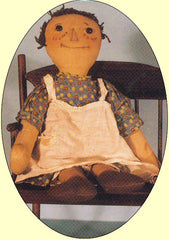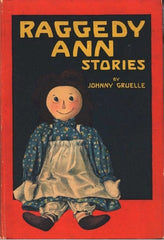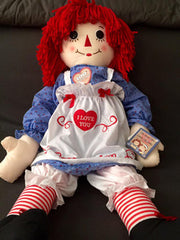
Original hang tag for Peter Playpal.
 |
| Madame Alexander doll with hang tag. |
Ephemera What?!!!! What is that?!!!!!
What?!!! Was my reaction to the word ephemera when I first heard
this term. Ephemera is an important part of doll collecting. This
is the term used for it€; minor documents of everyday life, non-book printed matter, principally of paper designed in the main for short term use, often for simplicity of disposal€ as defined by The Ephemera Society founded in 1975.
For doll collectors ephemera are simply the paper that comes with
the dolls or relates to dolls. There are all categories of ephemera,
but for the true doll collector it is doll paper and is a way to add
variety to your collection.
Doll paper can be found anywhere. (even reproductions of ir can be found on ebay) It is through these tiny bits of
paper that historians have been able to document many dolls and write the reference books. Doll paper can be defined in two ways. The first way is paper that has a specific doll as the main subject and that gives information on that doll. These bits of paper complete the story of the doll; often giving information that is vital. Doll papers that are important to a specific doll include: boxes, hang tags, certificates, booklets and other written information that comes with a doll when purchased new. Much of this material is lost as the doll ages and in order to make the doll complete again the doll papers are important. Also included in this category are paper dolls of actual dolls such as Crissy, Mrs. Beasley, Barbie and Chatty Cathy to name a few. Paper doll collecting is not to be confused with doll paper collecting. Doll paper collecting is a very inexpensive way for collectors to add interest to their collections. A Chatty Cathy doll collection would be more interesting to have a book of Chatty Cathy Paper dolls included.
The prices of dolls that still have their original doll papers command higher prices shows the importance of doll paper.
The second category of doll paper collecting can be categorized by
paper that has dolls as the secondary subject. Advertising using
dolls to enhance a product such as old magazine ads. Some of these ads can be found as far back as the 1870's. Toy catalogs that have many dolls are important to collectors to gain information on the original issue of their dolls. Toy catalogs are not easy to find
especially the older ones as collectors usually snap them up at doll
shows, flea markets, estate sales and anywhere else they can be
found. A booklet issued by Mattel showing the many fashions for
Barbie is of great importance to Barbie collectors.
Christmas cards with pictures of dolls can be a great doll paper
collectibles, as can old photographs of children with their dolls.
Even the post office has issued many doll stamps. The US Post Office issued a set of stamps a few years ago featuring Classic American Dolls and many countries also issue stamps with dolls on them. All the major pattern companies issue doll-clothing patterns for more popular dolls. Books are another important category that features dolls. Many dolls have been released based on the characters in a book and books have been written using a popular doll as the main character. There are many coloring books, puzzles and even sticker books. A few pieces of old sheet music can be found with dolls on the cover. Another category has recently been added to doll paper collecting and that is magazines and reference books, especially the older ones. The list of doll paper is endless and perhaps one of the most interesting is Charming Chatty on the cover of the December 7, 1963 issue of The Saturday Evening Post magazine. So I ask, Do you
collect ephemera?
Storing Doll Paper
All papers that will be kept for long periods should be at a humidity level of about 50%. Too much moisture will cause paper to mold.
Keep paper out of all light. Too much light can make paper brittle
Avoid extreme temperatures. Do not store papers on top of each other as colors may bleed. Do not use transparent tape, as it will stain the paper. Use acid free envelopes and folders to store papers in.
Remember each piece of doll paper lost is history lost.
This is another interesting part of collecting. As for me the only paper I might keep would be a hang tag. The only piece of ephemera I have kept is a letter written by a nurse to a doll seamstress in the early 1930's ordering a replica of her nursing uniform for her doll. She enclosed a picture of herself in her uniform. The doll is an A&M porcelain doll from Germany and I am guessing the doll was about ten years old at the time. I bought the doll about 20 years ago from a doll dealer, who told me she had bought the doll at an estate sale. I love when I know some of the history on my dolls.
A certificate of authenticity for a Lenci doll and a hang tag.
 |
| 1997 USA issue doll stamps |
As you can see there are many kinds of ephemera you can add to your doll collection.











